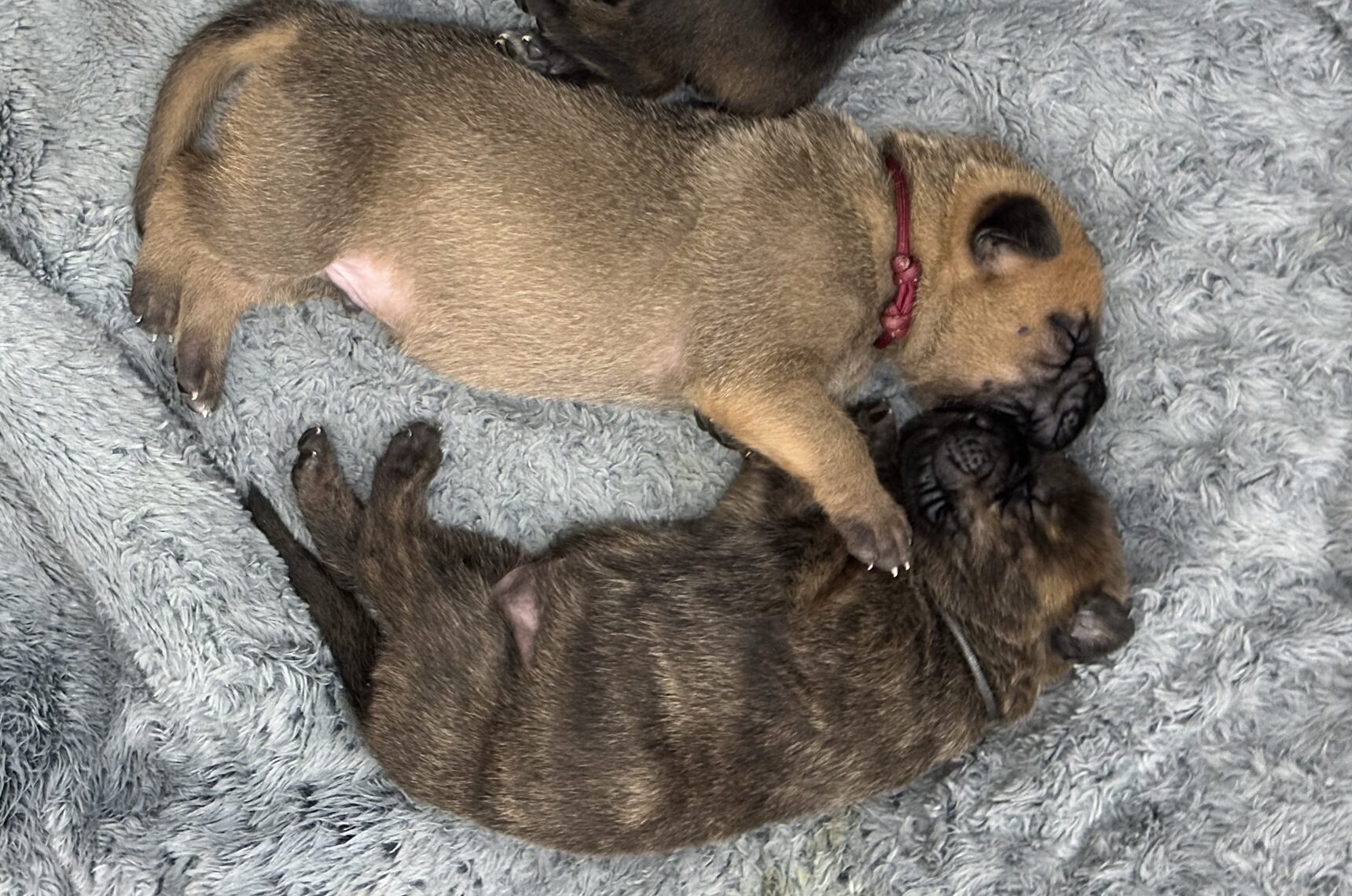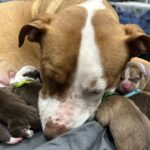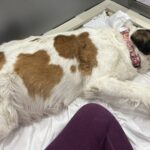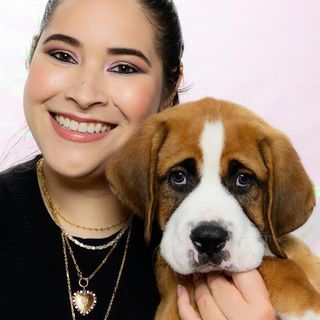If you need to learn how to bottle feed a newborn puppy, you’ve come to the right place! As an experienced bottle baby foster and medical foster, I have had to bottle-feed and tube-feed my fair share of newborns. I’ve tried to share all of the tips and tricks I’ve accumulated and discovered through those experiences.
My foster roster includes over 25 orphaned bottle babies along with providing supplemental feedings to fully bottle feeding over 45 additional newborns (who had moms that weren’t making enough milk or quit early on me!).

What You Need to Bottle Feed a Newborn Puppy
No matter what rescue I foster bottle babies for, I definitely have my preferred supplies based on trial and error through so many different newborns. I’ve compiled a list of general supplies along with my personal recommendations. It is important to have some flexibility as different puppies may prefer different bottles or nipples.
- Milk Replacement Formula (Breeder’s Edge Foster Care GM)
- Bottles, 2 oz. or smaller preferred (Dr. Brown’s Anti-Colic, Narrow 2 oz.)
- Nipples, preemie-sized preferred (Dr. Brown’s Natural Flow Preemie)
- Nutritional Calorie Gel (Tomlyn Nutri-Cal)
- Baby or Pet Scale (Greater Goods Pet Scale)
- Dry Baby Wipes (Honest Dry Baby Wipes)
- Wet Pet Wipes (Petkin Large Wipes)
- Pee Pads, disposable, extra small (13″ x 18″ Training Pads)
- Lubricant (Surgilube or Medline Petroleum Jelly, individual packets)
- Thermometer (Boncare Digital Thermometer)
- Bulb Syringe (Innovo Baby Bulb Syringe)
The following list of supplies are nice-to-have in your bottle feeding arsenal but are not necessary:
- Electric Tea Kettle (Hamilton Beach Electric Tea Kettle, Cordless)
- Bottle Warmer (Dr. Brown’s Insta-Feed Warmer and Sterilizer)
- Shaker Bottle (Blender Bottle)
- Mini Shaker Balls (Mini Shaker Balls)
- Silicone Nipples (Miracle Nipple or equivalent)
- Latex-Free Gloves (Nitrile Exam Gloves)
Bottle Feeding Setup
When working with neonates, you want to have everything ready to go before you start attempting to feed them as you’ll have to remove them from heat (which they need constantly!). I recommend setting up on a flat surface that is easy to clean; this could be a kitchen/bathroom counter top, desk, or folding table. As you become more experienced, you can definitely alter the set-up and even feed in your lap over a towel.

I like to place the disposable pee pad in the center of the area I’m working on and have both dry and wet wipes available. This area is where I will stimulate the puppy prior to feeding and where I will feed the puppy. If you are supplement-feeding only and have a mom who handles the cleaning, the wipes and pee pad are there just in case.
I use the left side for tools: scale to weigh before and after feeding along with a thermometer and lubricant to take the puppy’s temperature if I am concerned it is too cold to feed. I use the right side for the “food” items, which includes the filled baby bottle I plan to use and nutritional calorie gel. This is also where I place a baby bottle warmer, any additional nipples I might need, or additional formula if I am feeding multiple puppies.
Once you have the newborn puppy out, you don’t want to have to put it back to grab something you forgot! Always double-check that you have everything you need before you start to feed your pup.
Bottle Feeding Newborn Puppy Step-by-Step Guide
To bottle feed a newborn puppy, you’ll need to start by preparing the formula, then ensuring the puppy can be fed, and then feeding the puppy.
Preparing the Formula
To prepare the formula, you will need to first heat up water, whether running the tap, microwaving water, or using an electric tea kettle. The latter I find is the most accurate and reliable way to heat up water quickly.
Next, measure the milk replacement formula, which likely comes in the form of a dry powder. The majority of commercial milk replacers are one part powder formula to two parts water, but you will want to read the instructions on the container (and it never hurts to read it two or three times if you’re new to bottle feeding!).
Place the dry powder into a shaker bottle, and then add the water. I typically use one part of hot water (160 to 185 degrees F) and one part tap water (room temperature) to get to a formula temperature of around 110-115 degrees F. Your formula will cool down as you mix it in the bottle, which is room temperature, and by the time you go to feed, it will be 95-100 degrees–100 degrees is the most ideal temperature to feed at.1
Vigorously shake the formula and water to fully combine, and if the formula remains lumpy, you may need to add a little extra water to help smooth it out. This is where shaker balls come in handy, as they can also be placed in a baby bottle to keep lumps from forming. If there are clumps or lumps, they can easily clog the nipple and prevent the puppy from eating.
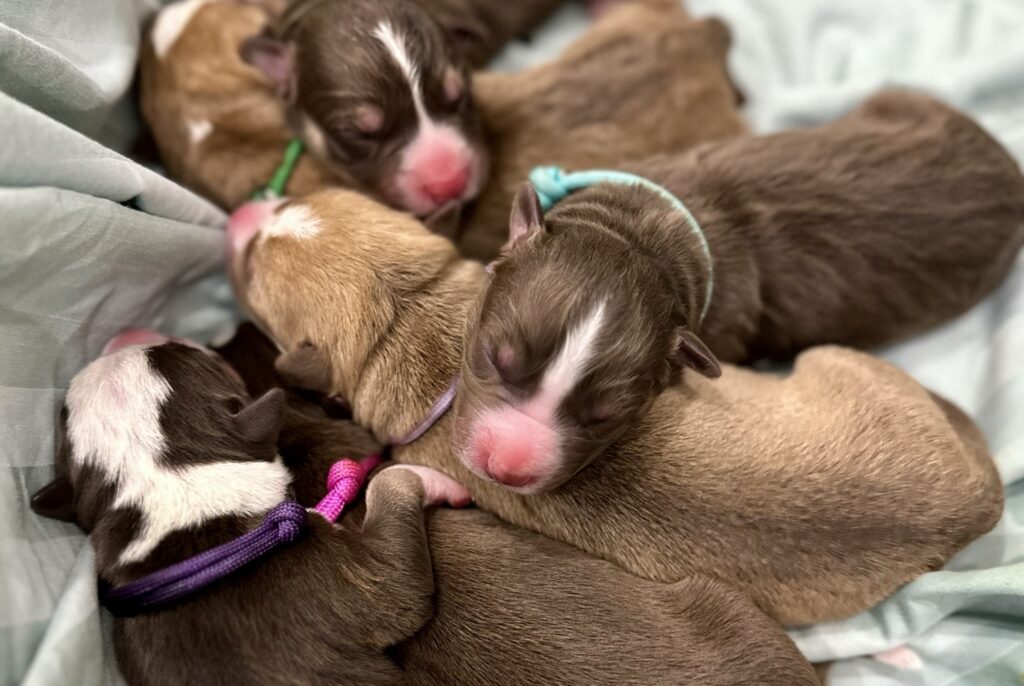
Preparing the Puppy for Bottle Feeding
There are a few things that must be done prior to actually feeding your puppy, which includes stimulating them to go potty, weighing them, and ensuring that they are warm enough to be fed. Once you’ve done these things, you can finally feed the hangry pup!
First, if the puppy needs to be stimulated, do so by gently rubbing the area between the anus and the genitals with a dry baby wipe, which will absorb the urine better and prevent them from being overly moist. You only need to do this for one or two seconds, let them release urine, and then repeat until they have run out of urine or have stopped pooping. You never want to rub and rub if nothing is coming out, and it isn’t necessary to directly rub their butts (doing this excessively can lead to soreness for them!).
I stimulate prior to feeding because it gives me a more accurate before and after weight and keeps their attention focused on feeding instead of them unlatching to do so. After they’ve successfully gone potty, I put them on the scale to get a before-feeding weight. Ideally, you’ll be able to determine how much volume (milk) they drank but also see how that translates into increased weight. However, sometimes milk spills out, so ensuring that they have the expected gain is confirmation they actually drank the formula.
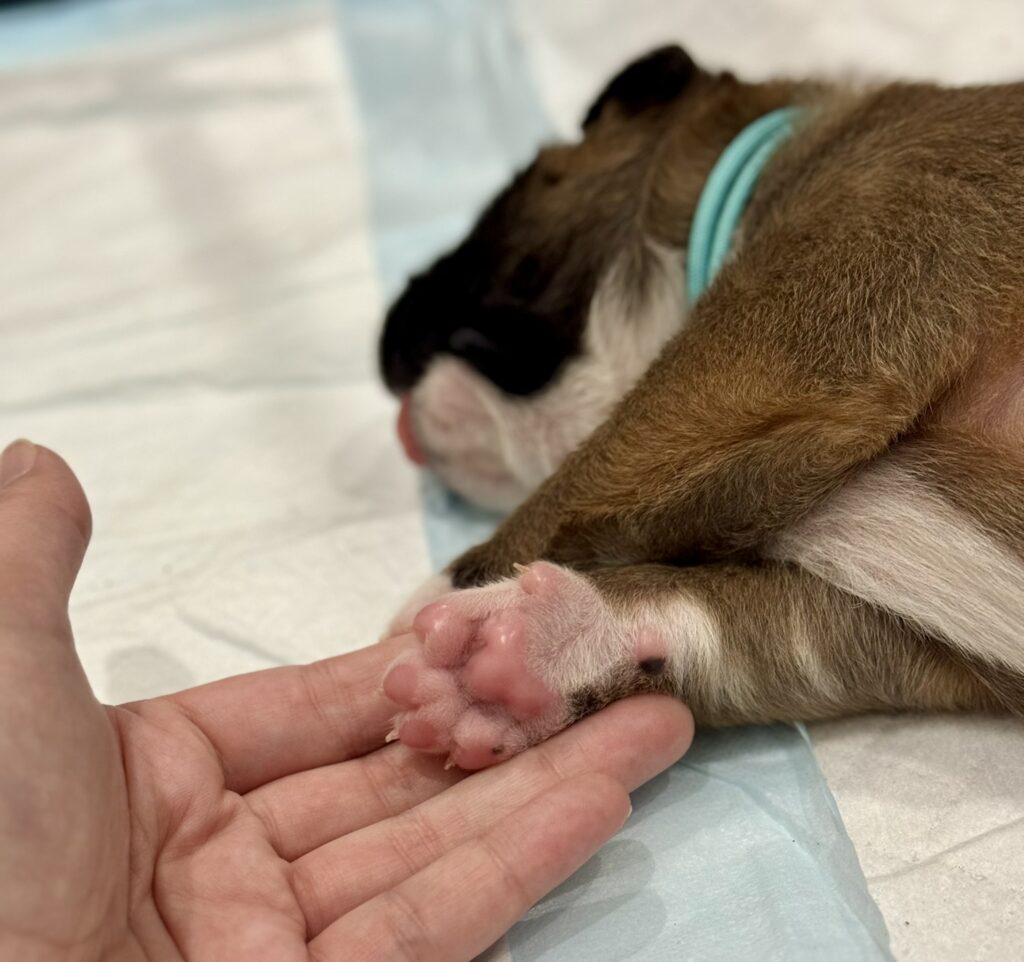
By stimulating and weighing them, you should have handled them enough to get a sense of whether they’re chilled or not, but if you are in doubt, do not be afraid to take a rectal temperature. You want the puppy to be at least 96 degrees before feeding, though bottle babies who have proper heating should typically be closer to 97-98 degrees in the first week and 98-100 degrees in the second and third weeks. You risk the puppy vomiting or regurgitating if you attempt to feed it while chilled, and this could lead to aspiration and then aspiration pneumonia (life-threatening).2
If a puppy is below 96 degrees but higher than 94 degrees and has otherwise been doing well, place it back on heat and allow it to warm up before feeding it. If the puppy is below 94 degrees or has become lethargic, weak, etc., refer to our post on Newborn Puppies: When to Be Concerned.
Bottle Feeding the Puppy
Hurrah! The puppy is warm, weighed, and ready to slurp down the formula! Healthy newborns should have a strong suckle and root around for the nipple, and after enough bottle feedings, they’ll start to smell the formula and you’ll see them squirm for it.

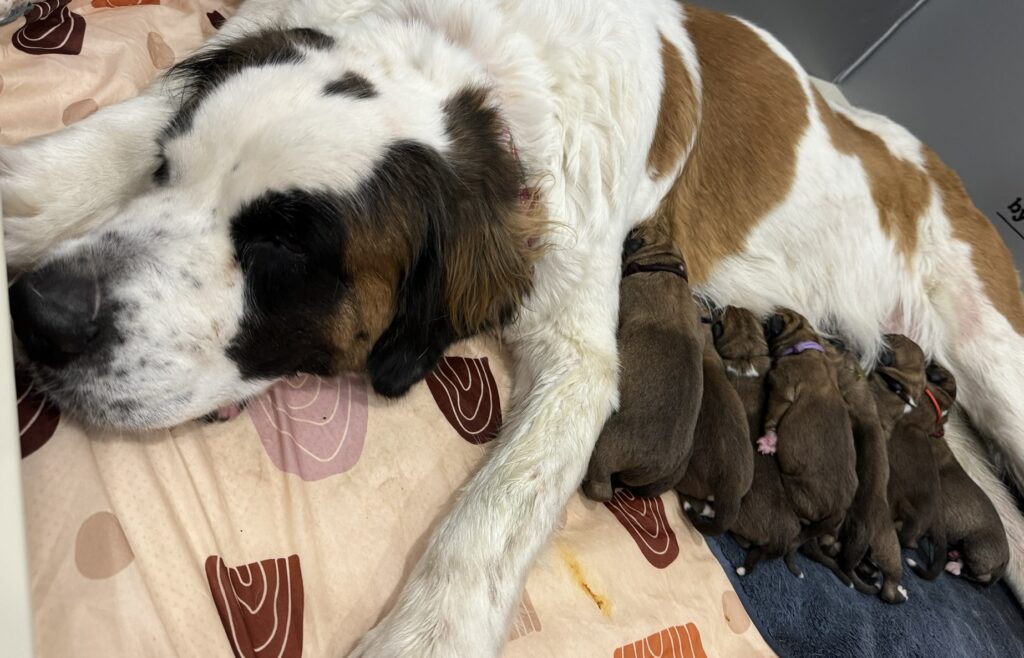
The position of the pup and the bottle should be trying to mimic the same position the pup would put itself in when trying to nurse from its mother.3
The puppy should be placed on a flat or stable surface, over the disposable pee pad or a towel, with your dominant hand holding the bottle with the nipple pointing towards the puppy’s mouth.
The bottle should primarily be resting in the palm of your hand, while your thumb can gently guide the puppy’s head into place and your other fingers working as a “wall” to help the puppy stay in position. We are not trying to force the puppy into a position but help it stay in the right position.
The puppy should have its rear legs on the flat surface or your lap with its front legs propping itself up on the surface or dangling off your non-dominant hand.
Their head should be tilted at about 45 degrees upward so that the milk will flow down their throat. You never want to feed a puppy on its back.
Your puppy may prefer to feed slightly more angled or less angled, but they should always be slightly angled towards the ceiling when latched. The puppy may also pull their head to one side, which is just fine.
As your puppy consumes formula, if you have put more formula than they need in the bottle, you’ll need to check for how much they’ve consumed by looking for decrease in milk in the bottle and/or by weighing them.
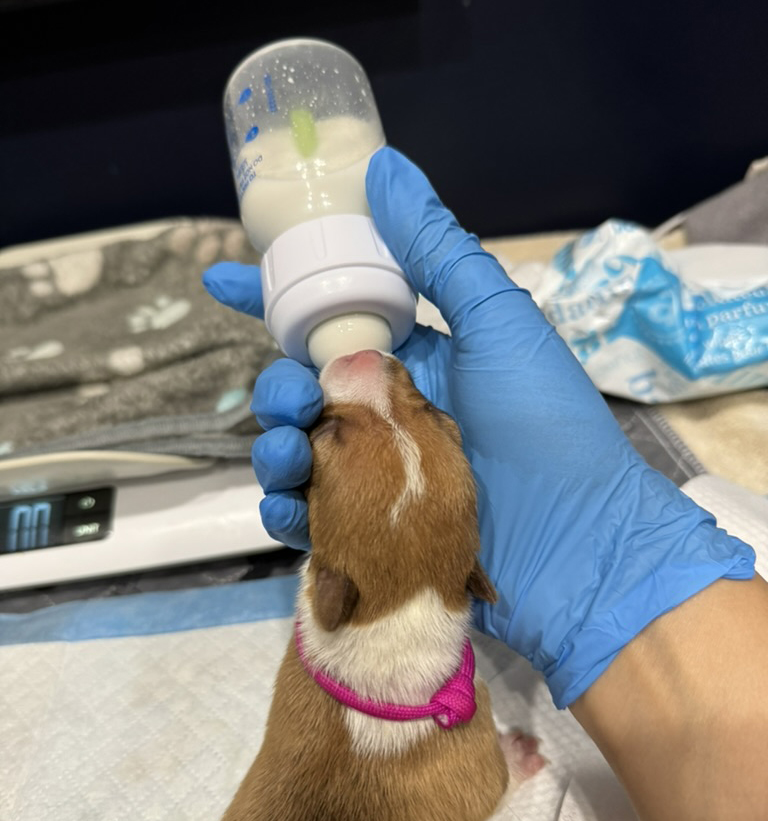
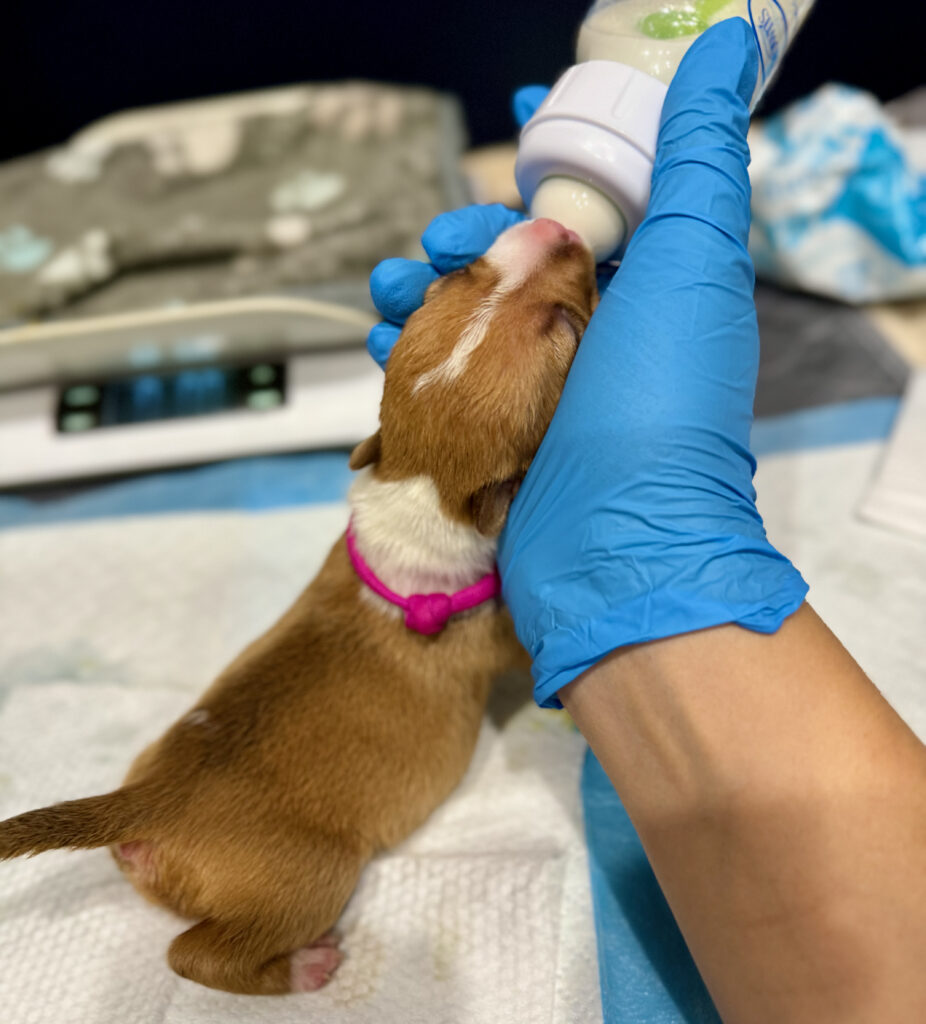

If they need to drink more, repeat the steps above. If they have drank enough, you can wipe off any milk mustache and gently pat their back (in the same position that you fed them in) to burp them in the event they have excess air in their belly.
After you’ve finished bottle feeding your pup, you will need to properly clean and sanitize out all used equipment. Most commercial milk replacers allow for constituted formula to be kept in the refrigerator for up to 24 hours. If the formula has been left at room temperature for an hour or longer, it should be discarded.4
How Much to Bottle Feed a Puppy
Neonates need between 20 and 26 kcal/100g of body weight, and the majority of milk replacers contain 1 kcal/ml.5 The stomach capacity of a neonate is approximately 4 ml/100 g of body weight. This helps us be able to calculate a maximum that can be fed to a neonate based on their current weight.
For quick conversion, based on six feedings per day, you would feed 1ml per 1 oz. of body weight. This is an approximation that will yield just under the “most ideal” calculation. Below, you can find charts for body weight measured in grams and body weight measured in ounces.
Remember, it is better to underfeed a puppy and gradually increase as appropriate than to overfeed, which can lead to diarrhea (often yellow and looser). From a physical standpoint, the puppy’s tummy should be distended but not stretched.6
Bottle Feeding Chart for Puppies Weighed in Ounces
The bottle feeding chart below is for easy reference for those weighing their puppies in ounces.
| Weight (ounces) | Calories per Day (kcal) | Formula per Day (ml) | Formula per Feeding (ml) | Feedings per Day |
|---|---|---|---|---|
| 2 | 13 | 13 | 2 | 6 |
| 3 | 20 | 20 | 3 | 6 |
| 4 | 26 | 26 | 4 | 6 |
| 6 | 39 | 39 | 7 | 6 |
| 8 | 52 | 52 | 9 | 6 |
| 10 | 65 | 65 | 11 | 6 |
| 12 | 78 | 78 | 13 | 6 |
| 14 | 91 | 91 | 15 | 6 |
| 16 (1 lb.) | 104 | 104 | 17 | 6 |
| 20 | 130 | 130 | 22 | 6 |
| 24 | 156 | 156 | 26 | 6 |
| 28 | 183 | 183 | 30 | 6 |
| 32 (2 lbs.) | 209 | 209 | 35 | 6 |
| 40 | 261 | 261 | 43 | 6 |
| 48 (3 lbs.) | 313 | 313 | 52 | 6 |
| 64 (4 lbs.) | 417 | 417 | 70 | 6 |
| 80 (5 lbs) | 522 | 522 | 87 | 6 |
| 96 (6 lbs.) | 626 | 626 | 104 | 6 |
| 112 (7 lbs.) | 730 | 730 | 122 | 6 |
Bottle Feeding Chart for Puppies Weighed in Grams
The chart below is a reference for how much formula (in ml) to feed based on a puppy’s weight measured in grams.
| Weight (grams) | Calories per Day (kcal) | Formula per Day (ml) | Formula per Feeding (ml) | Feedings per Day |
|---|---|---|---|---|
| 50 | 12 | 12 | 2 | 6 |
| 100 | 23 | 23 | 4 | 6 |
| 150 | 35 | 35 | 6 | 6 |
| 200 | 46 | 46 | 8 | 6 |
| 250 | 58 | 58 | 10 | 6 |
| 300 | 69 | 69 | 12 | 6 |
| 350 | 81 | 81 | 13 | 6 |
| 400 | 92 | 92 | 15 | 6 |
| 450 | 104 | 104 | 17 | 6 |
| 500 | 115 | 115 | 19 | 6 |
| 600 | 138 | 138 | 23 | 6 |
| 700 | 161 | 161 | 27 | 6 |
| 800 | 184 | 184 | 31 | 6 |
| 900 | 207 | 207 | 35 | 6 |
| 1,000 | 230 | 230 | 38 | 6 |
| 1,250 | 288 | 288 | 48 | 6 |
| 1,500 | 345 | 345 | 58 | 6 |
| 2,000 | 460 | 460 | 77 | 6 |
| 2,500 | 575 | 575 | 96 | 6 |
| 3,000 | 690 | 690 | 115 | 6 |
| 3,500 | 805 | 805 | 134 | 6 |
How Often to Bottle Feed a Puppy
It is appropriate to bottle feed a puppy every three to four hours, or six times a day, but it will depend on the puppy you have and whether they have any complications. A healthy bottle baby can go as long as six hours between feedings if it is getting fully fed, but a more critical, high-risk bottle baby may need to eat less per feeding and be fed every two hours.
In general, your bottle baby will cry if it’s hungry, so you can let the health of your puppy and its demeanor guide you on whether two, three, four, etc. hours between feedings is appropriate. It’s incredibly important for newborn puppies to get the sleep they need, so if they’re sleeping soundly after two hours, there’s no reason to wake it up just to feed it (unless medically necessary).
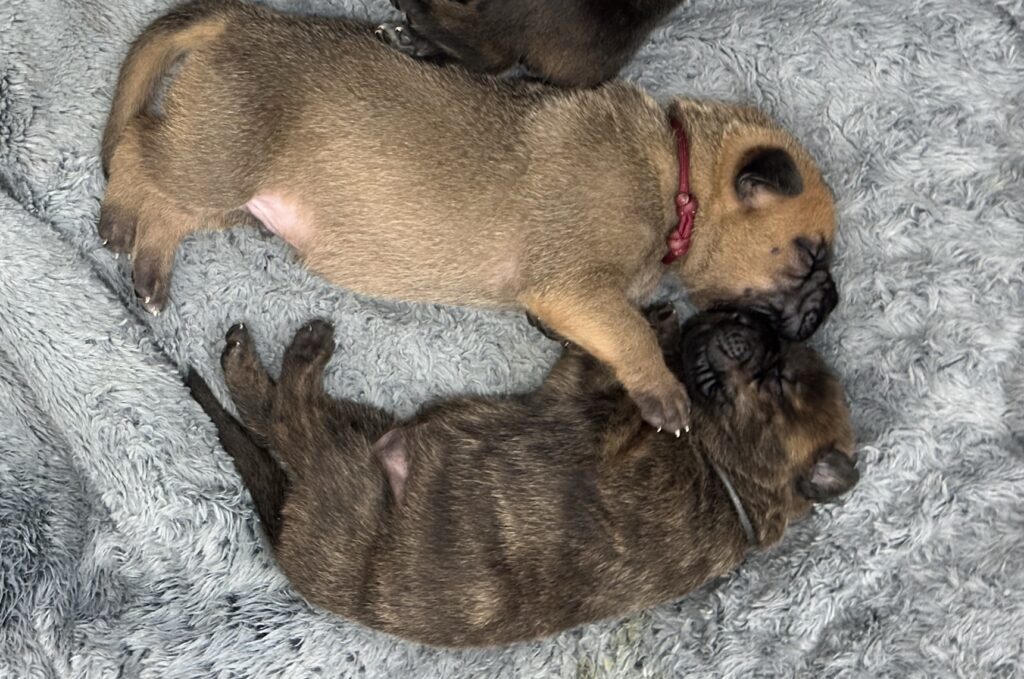
For healthy(ish!) bottle babies, you can try going four hours between feedings and then adjust. For at-risk bottle babies, you should start with feedings every three hours until they start to stabilize, which would be indicated by consistent weight gain, holding temperature, and staying hydrated.
Bottle Feeding Troubleshooting
The most common issues new bottle baby feeders encounter are: getting the puppy to latch, slow feedings, and failure to gain weight (or losing weight) or not eating.
Puppy Won’t Latch on Nipple
The first thing to double-check is that the puppy is at least 96 degrees (preferably 97-98!) in temperature, as chilled puppies can have a weak latch. The second is to make sure that the flow of the milk is not too fast and not too slow. If it is too fast, then the puppy can choke on the milk and have it come up through its nose, but this also makes it hard for the puppy to maintain a suckle. If it’s too slow, the puppy may get tired or give up, especially if they are at-risk and a bit weaker.
If the formula is dispensing appropriately through the nipple, and the puppy seems hungry, you can try a different nipple. I prefer preemie nipples to start and then go down to a softer, more pliable silicone nipple inserted into the Dr. Brown’s cap. These can be squeezed a bit to more readily entice the puppy to taste the formula and get them interested in the formula. You can also widen the opening on a nipple using a tine from a fork and gently stretching the opening.
It is appropriate to (as gently as you can) open the puppy’s mouth to insert the nipple, and you will want to make sure their tongue is underneath the nipple. You can try to pull the nipple slowly away from their mouths, which an encourage them to latch with more vigor. I also will use my dominant thumb to gently stroke the puppy’s head as if it was nursing while using my non-dominant hand lightly pressed against the puppy’s head to mimic the feel of siblings crowding it around mom’s nipple. This can give them a sense of competition and make them latch better.
You can also give them a dose of nutritional calorie gel smeared onto their gums, which may help increase their appetite and give them more energy.

Takes the Puppy a Long Time to Feed
The two most common culprits are the puppy is lethargic or weak, so it’s unable to latch and create enough suction to get the formula out, or the flow is too slow from the nipple, which is usually related to a pup’s ability to suckle, so the two tend to feed into each other.
You’ll want to check to make sure that the formula is still warm enough (between 95 and 100 degrees) and hasn’t chilled the puppy while it’s been working. You’ll then want to check the flow of the nipple if the pup seems to have a decent latch. You can also widen the opening on the nipple using a tine from a fork and gently stretching the opening.
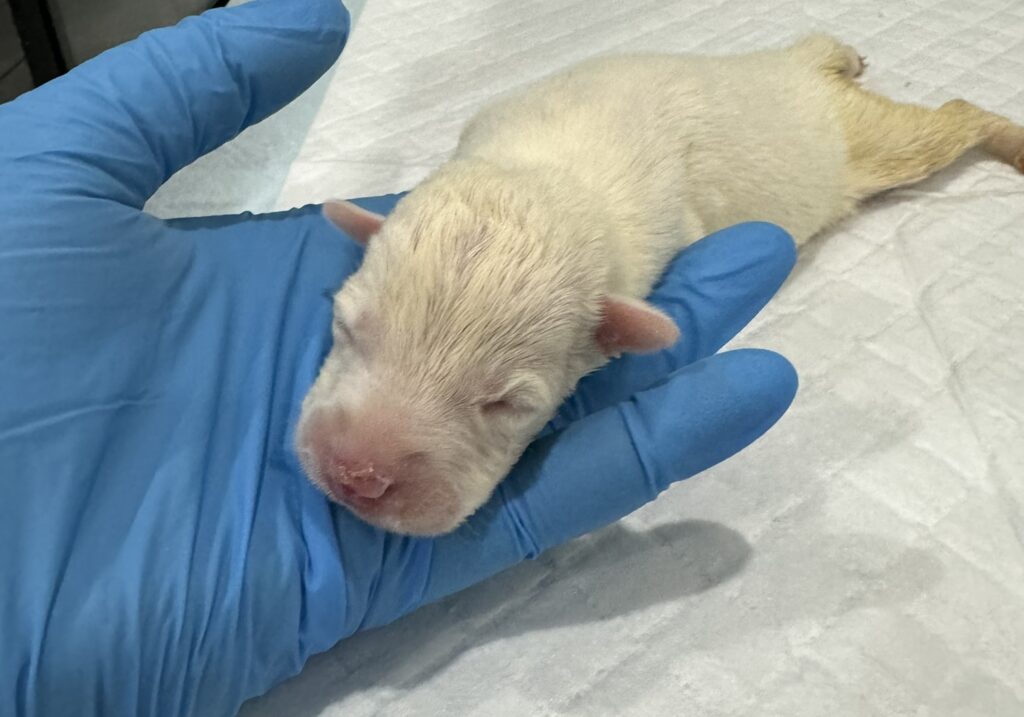
Not Eating or Failure to Gain Weight/Losing Weight
First and foremost, stay calm, cool, and collected. If you’ve tried to troubleshoot a puppy not latching and are still struggling, the best thing you can do is smear calorie gel on its gums and give it time to rest. This will provide the puppy some nutrition to hold it over while you dive deeper into why it might not be eating.
If a puppy has been gaining weight steadily until a recent feeding, it may simply be full. It may also need to poop. It’s when a puppy hasn’t gained weight over a 24 to 48 hour period (or has lost weight) that your next stop would be read through the signs of failure to thrive or fading puppy syndrome. This is especially true if your pup has started to appear weak, lethargic, or has difficulty breathing.
You will also want to make sure that you are feeding your pup enough formula per feeding to meet its caloric needs. You may try increasing the amount you’re feeding by 10% and seeing how the pup takes that.
The last thing you can check is if it is dehydrated, which can also have other symptoms, but it can result in weight loss.
Hopefully, this in-depth guide has helped you learn how to bottle feed and gain some confidence in giving it a go! There are a lot of steps and rules to doing it right, but you will get the hang of it after a few feedings. When in doubt, take a breath and put the puppy back in its warm place, and regroup if you are frustrated or having any issues. You can do it! You are giving a puppy the extra love, attention, and care it needs to even have a chance to survive!
Footnotes
- Bottle Feeding Puppies and Kittens. (2023, November 8). Revival Animal Health. https://www.revivalanimal.com/learning-center/bottle-feeding-puppies-and-kittens ↩︎
- Caring for Orphaned Puppies | VCA Animal Hospital | VCA Animal Hospitals. (n.d.). Vca. https://vcahospitals.com/know-your-pet/puppy-orphaned ↩︎
- Feeding Orphaned Puppies | VCA Animal Hospital | VCA Animal Hospitals. (n.d.). Vca. https://vcahospitals.com/know-your-pet/feeding-orphaned-puppies ↩︎
- Feeding Orphaned Puppies | VCA Animal Hospital | VCA Animal Hospitals. (n.d.). Vca. https://vcahospitals.com/know-your-pet/feeding-orphaned-puppies ↩︎
- A Guide to Newborn Puppy Intensive Care | Vet Focus. (n.d.). https://vetfocus.royalcanin.com/en/scientific/a-quick-guide-to-intensive-care-of-newborn-puppies ↩︎
- Avoid Bottle Feeding Issues in Kittens and Puppies. (2023, February 17). Revival Animal Health. https://www.revivalanimal.com/learning-center/avoid-bottle-feeding-issues-in-kittens-and-puppies ↩︎

